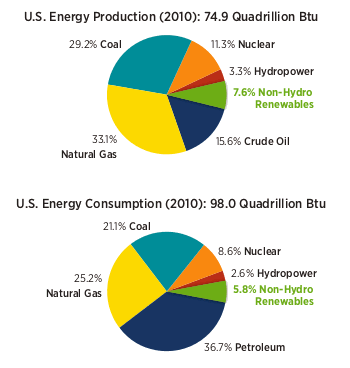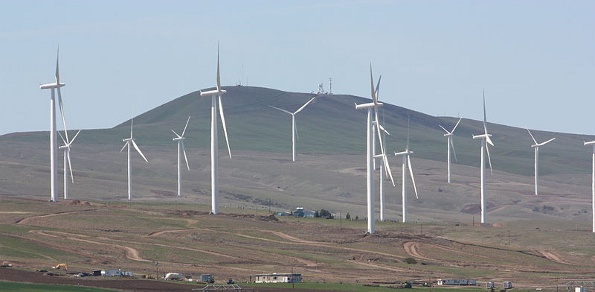Worldwide Wind
September 17, 2012
Our
energy supply comes from a
hodge-podge of sources, such as
hydroelectric,
coal/oil/natural gas,
nuclear reactors; and recently the
renewable energy technologies of
solar photovoltaic. There's also
wind power, which, like hydroelectric, is really another form of
solar energy.
This is not an "Energy Blog," but so much
science and technology concerns renewable energy that I've posted quite a few articles on the topic. Here are a few.
• There's a Hot Wind A-Blowin', May 7, 2012
• Solar Energy Scorecard, April 30, 2012
• However the Wind Blows, February 7, 2012
• Ternary Pyrite Photovoltaics, December 15, 2011
• Kind of a Drag, August 10, 2011
• Taxing Times for Solar, July 28, 2011
• Manganese Photolysis of Water, June 1, 2011
• Salt Water Energy, May 20, 2011
• Titania Photocatalysis, February 16, 2011
• US Offshore Wind Strategy, February 15, 2011
• Pyrite Photovoltaics, January 24, 2011
• Bigger than a Butterfly, January 11, 2011
• Atlantic Wind Power, November 11, 2010
• Flutter Power, August 17, 2010
• Solar Salt, July 30, 2010
Wind power is relatively low-tech compared with photovoltaics and some of the more exotic
energy-harvesting principles I've described, and it's rather easy to implement. To an engineer, one
turbine-generator is like any other, whether driven by the wind,
steam, or
flowing water.
Wind power produced a little more than a percent of US energy in 2010, but that present small percentage belies a huge global trend. As reported by the
US Department of Energy in its 2010 Renewable Energy Data Book, October, 2011,[1]
Worldwide, wind energy is one of the fastest growing renewable energy technologies - between 2000 and 2010, wind energy generation worldwide increased by a factor of 11. The United States experienced even more dramatic growth, as installed wind energy capacity increased by a factor of nearly 16 between 2000 and 2010.

1.2% of US energy production in 2010 came from wind power, but the real story is in the rising tide of wind power.
The installed capacity of wind energy increased by a factor of nearly 16 in the US in the decade from 2000-2010.
(US Department of Energy, 2010 Renewable Energy Data Book, October, 2011,
page 7).[1)]
Sometimes,
scientists ask strange questions hoping to get interesting answers. Could scaling wind power from the present one percent to a hundred percent be practical? Could wind power provide all the world's energy needs?
Those are the questions that
Mark Z. Jacobson, a
professor of
civil and environmental engineering at
Stanford University, and
Cristina L. Archer, an
associate professor of
geography and
physical ocean science and engineering at the
University of Delaware, asked. Their answer to these questions, as presented in a recent paper in the
Proceedings of the National Academy of Sciences, is that wind could supply several times the world's energy requirement by 2030.[2-4]
The human energy requirement in the year 2030 is projected to be 11.5
terawatts annually,[2] but the problem is not just one of dividing this number by the annual power output of an isolated wind turbine to see how many you need. Previous studies have shown that turbines will steal wind from each other to lower overall efficiency; and wind turbines modify
climate by mixing the layers of the
atmosphere.[2] I've reviewed both topics in previous articles.
The Stanford-Delaware scientists modified a
computer model, called GATOR-GCMOM,[5] to calculate the maximum power that might be extracted from the wind, taking into account the turbine-turbine interaction. The calculation divided the atmosphere into
voxels, which are small volume regions, and it included factors such as
water vapor content.[2-3] The model wasn't just concerned with the potential power available from wind turbines. It further calculated the affect of the turbines on
global temperatures,
moisture,
clouds and climate.[2]
The model assumed that wind turbines could be installed anywhere, without regard to things such as
zoning laws or the
economics of the installation.[2] With this assumption, it was possible to calculate a saturation wind power potential, which is the maximum energy that can be extracted from
Earth's winds by wind turbines. If you a able to place 100-
meter-tall wind turbines over the entire (land plus water) surface of the Earth, this saturation point is an impressive 250 terawatts.[4]

Looking like a scene from the Original War of the Worlds film, a wind farm at Windy Flats, Washington State. This photograph is by Walter Siegmund, via Via Wikimedia Commons)
A more economically viable placement over just land and along the
coasts would give 80 terawatts, which is significantly higher than requirements. From that
reference point, the more expensive, or objectionable, turbines can be eliminated. If you could somehow site turbines at a six mile
altitude, in the
jet stream, an additional 380 terawatts can be extracted from the wind.[2,4]
Four million 5-megawatt 100 meter turbines could supply 7.5 terawatts, which is more than half the world's energy requirement, without significantly affecting the climate. [2-4] Half of these turbines would be on land, covering about 0.5% of the Earth's land area, and the other half over water. The land area would still be suitable for other purposes, such as
farming.[2] Says study co-author, Mark Jacobson,
"The careful siting of wind farms will minimize costs and the overall impacts of a global wind infrastructure on the environment... Regardless, as these results suggest, the saturation of wind power availability will not limit a clean-energy economy."[2]
Says study co-author Cristina Archer,
"Wind power is very safe from the climate point of view... Everything comes at a price, but the price of wind power comes at a low cost in terms of climate impacts."[3]
This research was funded by the
National Science Foundation, the
U.S. Environmental Protection Agency, and
NASA.[2]
References:
- US Department of Energy, 2010 Renewable Energy Data Book, October, 2011.
- Andrew Myers, "Wind could meet many times world's total power demand by 2030, researchers say," Stanford University Press Release, September 10, 2012.
- Teresa Messmore, "Wind power's potential: UD-Stanford team calculates maximum global energy potential from wind," University of Delaware News, September 10, 2012.
- Mark Z. Jacobson and Cristina L. Archer, "Saturation wind power potential and its implications for wind energy," Proc. Natl. Acad. Sci., September 10, 2012, doi:10.1073/pnas.1208993109.
- Mark Z. Jacobson, "History of, Processes in, and Numerical Techniques in GATOR-GCMOM," Stanford University Web Site, August 22, 2012.
Permanent Link to this article
Linked Keywords: Energy; hodge-podge; hydroelectricity; hydroelectric; fossil-fuel power station; coal; oil; natural gas; nuclear reactor; renewable energy; technology; solar photovoltaic; wind power; solar energy; science; energy-harvesting; turbine-generator; steam; flowing water; US Department of Energy; 2010 Renewable Energy Data Book, October, 2011; scientist; Mark Z. Jacobson; professor; civil and environmental engineering; Stanford University; Cristina L. Archer; associate professor; geography; physical ocean science and engineering; University of Delaware; Proceedings of the National Academy of Sciences; terawatt; climate; atmosphere of Earth; atmosphere; computer simulation; computer model; voxel; water vaporvglobal temperature; water vapor; moisture; cloud; zoning law; economics; Earth; meter; The War of the Worlds (1953 film); Windy Flats, Washington State; Wikimedia Commons; coast; reference point; altitude; jet stream; farming; National Science Foundation; U.S. Environmental Protection Agency; NASA.